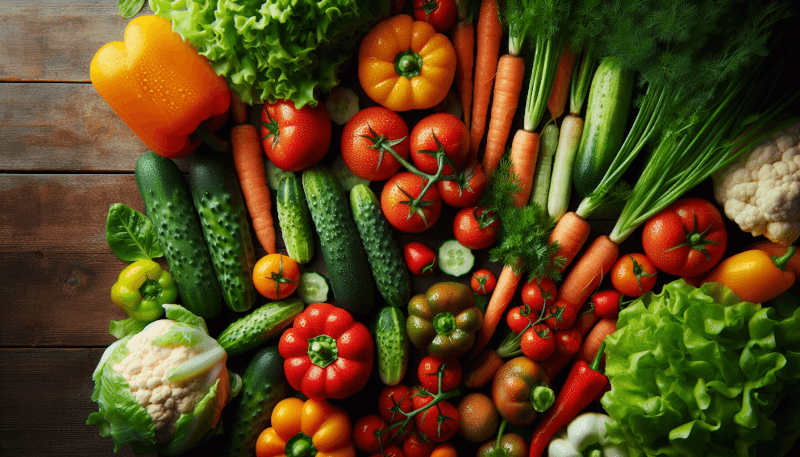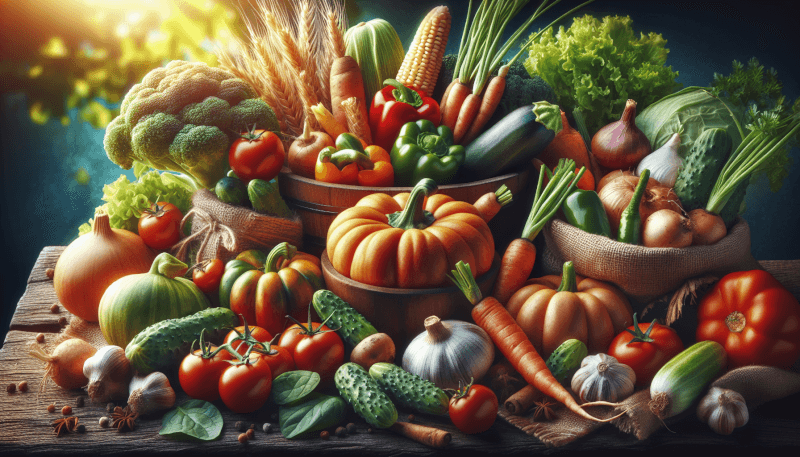Imagine stepping outside into your garden and being able to pluck the freshest, most vibrant ingredients for a delicious, nourishing meal. With the article titled “Healthy Soups And Stews Straight From Your Garden,” you can learn how to create hearty and nutritious soups and stews using ingredients straight from your own backyard. Discover the joy of harvesting vegetables and herbs to create simple yet flavorful dishes that will warm your body and delight your taste buds. Say goodbye to store-bought cans and packaged mixes, and embrace the satisfaction of creating homemade meals using your very own garden bounty. Get ready to savor the goodness of garden-fresh soups and stews that will leave you feeling healthy and satisfied.
Benefits of Homemade Soups and Stews
Making homemade soups and stews has numerous benefits that not only contribute to your overall health but also allow for a personalized touch in your cooking. By using fresh and nutritious ingredients, you can create wholesome dishes that are packed with vitamins and minerals. The control over ingredients and seasonings further ensures that you can cater to your specific dietary preferences and avoid any unwanted additives. Additionally, homemade soups and stews are generally high in fiber and low in calories, making them an excellent choice for those striving to maintain a healthy lifestyle. Lastly, the versatility and customizability of these recipes allow you to experiment with different flavors and textures, keeping your meals exciting and satisfying.
Fresh and Nutritious Ingredients
One of the greatest advantages of making soups and stews at home is the ability to use fresh and nutritious ingredients. By incorporating garden-fresh vegetables and herbs, you can ensure that your meals are packed with vitamins, minerals, and antioxidants. These vital nutrients not only promote a healthy immune system but also aid in digestion, improve energy levels, and support overall well-being. When you use fresh ingredients, you can taste the difference in the vibrant flavors and enjoy the natural goodness that comes from using produce straight from your garden.
Control over Ingredients and Seasonings
When it comes to your health, having control over the ingredients and seasonings used in your cooking is essential. Homemade soups and stews offer you the freedom to choose the quality and quantity of each ingredient. You can opt for organic or locally sourced produce to avoid potential pesticide exposure, genetically modified organisms (GMOs), or other harmful additives. Furthermore, if you have any dietary restrictions or specific flavor preferences, you can customize each recipe to suit your needs. By controlling the salt, sugar, and fat content, you can create meals that align with your nutritional goals and personal taste preferences.
High in Fiber and Low in Calories
For those looking to embrace a healthy lifestyle, homemade soups and stews are an excellent choice. These dishes are often high in fiber, which aids in digestion, promotes feelings of fullness, and can assist with weight management. By incorporating a variety of vegetables, legumes, and whole grains, you can increase the fiber content of your meals. Furthermore, soups and stews, especially those based on broth or stock, are generally low in calories compared to other comfort foods. This makes them a satisfying and guilt-free option that will keep you nourished without compromising on taste.
Versatile and Customizable Recipes
One of the great joys of making homemade soups and stews is the freedom to experiment with flavors and textures. There are endless possibilities when it comes to combining different vegetables, proteins, grains, and spices to create a dish that suits your taste buds perfectly. You can adjust the seasonings, add extra vegetables, or even incorporate unique ingredients to create a one-of-a-kind masterpiece. Whether you prefer a chunky vegetable soup, a hearty bean stew, or a creamy pureed creation, the possibilities are endless. By customizing your recipes, you can ensure that every bowl of soup or stew is a delicious and satisfying experience.
Growing a Soup and Stew Garden
If you want to take your soup and stew-making to the next level, consider growing your own soup and stew garden. Not only will it provide you with an abundant supply of fresh ingredients but it will also give you a sense of pride and satisfaction as you create meals using produce from your own backyard.
Choosing the Right Vegetables and Herbs
When planning your soup and stew garden, it’s important to choose vegetables and herbs that are well-suited for these types of dishes. Some vegetables that are commonly used include tomatoes, carrots, onions, garlic, leeks, celery, and potatoes. These vegetables provide a flavorful base for many soups and stews. Additionally, herbs such as basil, sage, thyme, rosemary, and parsley can add depth and complexity to your dishes. Consider the specific flavors and aromas you enjoy and select vegetables and herbs accordingly.
Planning and Preparing the Garden
Before you start planting, take the time to plan and prepare your soup and stew garden. Choose a sunny location with well-drained soil for optimal plant growth. Consider the spacing requirements of each vegetable and herb and arrange them accordingly. It’s also important to prepare the soil by removing any weeds or debris and adding compost or organic matter to enrich the soil. Proper planning and preparation will set the stage for a successful garden and ensure that your plants thrive.
Companion Planting for Soups and Stews
To maximize the productivity of your soup and stew garden, consider implementing companion planting techniques. Companion planting involves growing certain plants together to enhance growth, repel pests, and improve flavor. For example, planting aromatic herbs like basil and rosemary alongside your tomato plants can deter pests and enhance the flavor of the tomatoes. Similarly, growing carrots and onions together can help repel pests that may damage these crops. By strategically pairing plants, you can create a harmonious environment that benefits your soup and stew ingredients.
Organic Gardening Tips
If you prefer to grow your soup and stew ingredients organically, there are a few tips to keep in mind. First, avoid using synthetic pesticides, herbicides, or fertilizers, as they can introduce harmful chemicals into your garden and compromise the integrity of your produce. Instead, opt for natural alternatives such as neem oil, homemade compost, or companion planting techniques to manage pests and promote plant health. Be diligent in practicing organic gardening methods, such as proper watering, mulching, and crop rotation, to maintain a healthy and thriving garden. By growing your ingredients organically, you can ensure that your soups and stews are made with the highest quality produce.

Essential Ingredients for Healthy Soups and Stews
Creating delicious and nutritious soups and stews starts with selecting the right ingredients. By including a variety of key components, you can create well-rounded and satisfying dishes that are packed with flavor and goodness.
Broths and Stocks
The base of many soups and stews is a flavorful broth or stock. Broths are typically made by simmering vegetables, herbs, and aromatic spices in water, while stocks often include animal bones or seafood shells for added depth of flavor. The choice between store-bought or homemade broths and stocks is entirely up to you. Homemade versions allow for full control over ingredients and flavors, while store-bought options offer convenience. Look for low-sodium or reduced-fat options if purchasing from the store, or follow a simple recipe to make your own at home.
Vegetables
Vegetables are the star of any healthy soup or stew. They provide essential vitamins, minerals, and fiber that contribute to overall well-being. Common vegetables used in soups and stews include carrots, celery, onions, garlic, bell peppers, potatoes, and tomatoes. You can choose to dice or slice them for a chunkier texture or puree them for a creamier consistency. Experiment with different combinations and quantities of vegetables to create a colorful and nutritious dish.
Herbs and Spices
Adding herbs and spices to your soups and stews can elevate the flavor to new heights. Herbs such as basil, thyme, oregano, sage, and rosemary can bring a fresh and aromatic element to your dishes. Spices like cumin, paprika, turmeric, and chili powder can add depth and complexity. Don’t be afraid to experiment with different flavor profiles and adjust the seasoning to your liking. Remember that a little goes a long way, so start with small amounts and taste as you go.
Grains and Legumes
To add heartiness and texture to your soups and stews, consider incorporating grains and legumes. Grains like rice, barley, quinoa, or pasta can provide a comforting and filling element, while legumes such as lentils, beans, and chickpeas offer a good source of plant-based protein and fiber. These ingredients not only enhance the nutritional value of your soup or stew but also contribute to its overall texture and richness.
Proteins
Protein is an important component of a balanced diet, and soups and stews can be an excellent way to incorporate it. Whether you prefer animal-based proteins like chicken, beef, or seafood, or prefer plant-based options like tofu or tempeh, there are endless possibilities when it comes to adding protein to your soups and stews. Select lean cuts of meat or opt for skinless, boneless options to keep your dishes healthy. For plant-based proteins, consider pre-cooking tofu or tempeh to enhance their texture and flavor.
Cooking Techniques for Flavorful Soups and Stews
The cooking techniques you employ can greatly influence the flavor and texture of your soups and stews. By utilizing various techniques, you can achieve depth, richness, and complexity in every bowl.
Sautéing and Browning
One of the first steps in creating flavorful soups and stews is to sauté and brown your ingredients. Sautéing your aromatics, such as onions, garlic, and herbs, in a bit of oil or butter can release their natural flavors and aromas. Browning meats or vegetables before adding them to the pot can add a depth of flavor that enhances the overall taste of your dish. This technique is particularly useful when making beef stews or hearty vegetable soups.
Simmering and Slow Cooking
Simmering and slow cooking are essential techniques that allow the flavors of your soups and stews to meld together over time. By bringing your pot to a gentle simmer and cooking it over low heat, you allow the ingredients to release their flavors and become tender. This slow and steady process ensures that all the flavors are well-incorporated and that the proteins and vegetables are cooked thoroughly. Additionally, the longer cooking times can result in richer and more concentrated flavors.
Blending and Pureeing
For those who prefer smooth and creamy soups, blending and pureeing is an excellent technique. By using an immersion blender or a countertop blender, you can create velvety textures and transform chunky soups into smooth and uniform creations. This technique works particularly well with ingredients such as butternut squash, cauliflower, or tomatoes. The blending process not only creates a pleasing texture but also allows the flavors to blend together seamlessly.
Layering Flavors
Layering flavors is a technique used to develop complex and well-balanced soups and stews. By adding ingredients at different stages of the cooking process, you can build depth and complexity. For example, sautéing onions and garlic before adding other vegetables can create a flavorful base. Adding herbs and spices midway through cooking can provide a burst of freshness. Finally, finishing the dish with a sprinkle of fresh herbs or a squeeze of lemon juice can add brightness and enhance the overall taste. By layering flavors, you can create soups and stews that have depth and nuance in every spoonful.

Recipes for Healthy Garden Soups and Stews
Once you have your garden-fresh ingredients and have mastered the techniques, it’s time to put them to use with some delicious and nutritious recipes. Here are a few recipes to get you started:
Fresh Tomato and Basil Soup
Ingredients:
- 6-8 ripe tomatoes
- 1 onion, diced
- 3 cloves of garlic, minced
- Handful of fresh basil leaves, chopped
- Olive oil
- Salt and pepper to taste
Instructions:
- In a large pot, heat olive oil over medium heat. Add onion and garlic and sauté until softened.
- Add diced tomatoes and cook until they release their juices.
- Season with salt and pepper and let the mixture simmer for about 20 minutes.
- Use an immersion blender or regular blender to puree the soup until smooth.
- Stir in fresh basil leaves and let the soup simmer for an additional 5 minutes.
- Adjust seasoning if needed and serve hot.
Butternut Squash and Sage Stew
Ingredients:
- 1 large butternut squash, peeled and diced
- 1 onion, diced
- 3 cloves of garlic, minced
- Handful of fresh sage leaves, chopped
- Vegetable broth
- Salt and pepper to taste
Instructions:
- In a large pot, heat olive oil over medium heat. Add onion and garlic and sauté until softened.
- Add diced butternut squash and cook until it starts to soften.
- Stir in fresh sage leaves and season with salt and pepper.
- Pour in enough vegetable broth to cover the squash.
- Bring the mixture to a simmer and let it cook until the squash is tender, about 20-25 minutes.
- Adjust seasoning if needed and serve hot.
Carrot and Ginger Soup
Ingredients:
- 1 pound carrots, peeled and roughly chopped
- 1 onion, diced
- 3 cloves of garlic, minced
- 2-inch piece of ginger, peeled and minced
- Vegetable broth
- Coconut milk (optional)
- Salt and pepper to taste
Instructions:
- In a large pot, heat olive oil over medium heat. Add onion, garlic, and ginger and sauté until softened.
- Add chopped carrots and cook for a few minutes.
- Pour in enough vegetable broth to cover the carrots.
- Bring the mixture to a simmer and let it cook until the carrots are fork-tender, about 20-25 minutes.
- Use an immersion blender or regular blender to puree the soup until smooth.
- Stir in coconut milk (if using) and season with salt and pepper.
- Adjust seasoning if needed and serve hot.
Feel free to experiment with these recipes by adding your favorite vegetables, herbs, or spices. Let your garden inspire you and create soups and stews that are uniquely yours.
Tips for Preserving Soups and Stews
If you find yourself with an abundance of soups and stews or simply want to enjoy them in the future, there are several techniques for preserving these dishes.
Freezing
One of the simplest and most convenient ways to preserve soups and stews is by freezing them. Allow the soups or stews to cool completely before transferring them into individual portion-sized containers or freezer bags. Be sure to leave some headspace to allow for expansion during freezing. Label each container with the name and date and store them in the freezer for up to three months. When ready to enjoy, thaw in the refrigerator overnight and reheat on the stovetop or in the microwave.
Canning
Canning is another popular method for preserving soups and stews. It requires some equipment and proper canning techniques to ensure food safety. Before attempting canning, familiarize yourself with the necessary steps and guidelines provided by reputable sources such as the National Center for Home Food Preservation. By following the proper canning procedures, you can enjoy your homemade soups and stews for an extended period without the need for refrigeration or freezing.
Mason Jar Meals
Another creative way to preserve soups and stews is by preparing them as mason jar meals. Layer the ingredients in clean and sterilized mason jars, starting with the proteins, followed by vegetables, grains, and finally, the broth or stock. Leave some headspace and seal the jars tightly. Refrigerate the jars for up to five days and heat them in the microwave or transfer the contents into a pot to reheat on the stove. Mason jar meals provide a convenient option for enjoying homemade soups and stews on the go or as quick meals during busy weekdays.

Garnishes and Accompaniments
To enhance the flavors and presentation of your soups and stews, consider adding garnishes and accompaniments. These additions can elevate the overall dining experience and provide a burst of freshness and texture.
Fresh Herbs
Sprinkle freshly chopped herbs, such as parsley, cilantro, or dill, over the top of your soups and stews to add a pop of color and vibrant flavors. The bright and aromatic herbs can provide a refreshing contrast to the rich and savory nature of the dish.
Crusty Bread
Serve your soups and stews with a side of crusty bread to soak up the delicious broth. Whether it’s a freshly baked baguette, a hearty whole grain loaf, or homemade cornbread, the addition of bread can complete the meal and provide a satisfying element of texture.
Grated Cheese
For a cheesy indulgence, sprinkle some grated cheese on top of your soups and stews. Consider options like Parmesan, Cheddar, or Gruyère to add a salty and creamy component. The cheese will melt into the warm broth and create a rich and comforting experience.
Sour Cream or Yogurt
Adding a dollop of sour cream or yogurt to your soups and stews can add a creamy and tangy element. It can balance out the flavors and provide a cooling effect, especially if your dish has some heat or spice. Opt for a full-fat or Greek yogurt for a smoother and more luxurious texture.
Sliced Avocado
For a creamy and healthy addition, slice up some ripe avocados and place them on top of your soups and stews. Avocado not only adds a richness but also contributes beneficial fats and nutrients. The smooth and buttery texture can complement the other ingredients and add a touch of indulgence.
Cracked Black Pepper
A simple yet effective garnish, freshly cracked black pepper can provide a hint of heat and a subtle spice to your soups and stews. By adding a few twists of the pepper mill, you can enhance the flavors and awaken your taste buds.
Feel free to mix and match these garnishes and accompaniments to create a personalized and delightful experience with each serving.
Hearty Soups and Stews for Different Seasons
Soups and stews are not only a comfort food for cold winter nights but can also be enjoyed throughout the year. By incorporating seasonal ingredients, you can create hearty and satisfying dishes that are well-suited for each season.
Spring Soups and Stews
During the spring, lighter and fresher flavors often take center stage. Opt for soups and stews that highlight the vibrant green vegetables that come into season, such as asparagus, peas, spinach, and leeks. Consider creating a spring minestrone that combines these vegetables with a light broth and sprinkling of fresh herbs. Alternatively, a creamy potato and leek soup can provide a comforting and satisfying meal as the weather begins to warm up.
Summer Soups and Stews
In the heat of summer, light and refreshing soups are the way to go. Cold soups like gazpacho, made with ripe tomatoes, cucumbers, and bell peppers, can provide a cooling effect on hot days. Additionally, chilled fruit soups, such as peach or watermelon, can be a refreshing and healthy way to enjoy the abundance of summer fruits. For those still craving warm dishes, consider lighter stews with seafood, such as a fisherman’s stew with fresh herbs and a squeeze of lemon.
Fall Soups and Stews
Fall is a time for heartier and more robust flavors. As the weather cools down, embrace the warm and comforting dishes that come with the season. Soups and stews made with butternut squash, sweet potatoes, apples, and warming spices like cinnamon and nutmeg can provide a cozy and satisfying meal. Consider a butternut squash and apple stew or a hearty bean soup packed with fall vegetables for a nourishing and flavorful experience.
Winter Soups and Stews
Winter is the perfect time for indulgent and stick-to-your-ribs soups and stews. Rich and robust flavors can take center stage using ingredients such as beef, root vegetables, barley, and warming spices like thyme and bay leaves. Braised beef stew with root vegetables or a classic beef and barley soup can bring comfort and warmth on cold winter days. Additionally, a slow-cooked chicken and vegetable soup with dumplings can be the ultimate winter comfort food.

Culinary Equipment for Soup and Stew Making
To create delicious soups and stews, it’s important to have the right culinary equipment on hand. These tools can streamline the cooking process and enhance the overall experience.
Soup pots and Dutch ovens
Investing in a quality soup pot or Dutch oven is essential for making soups and stews. These pots offer even heat distribution and can accommodate large quantities of food. Look for pots with thick bottoms and tight-fitting lids to ensure proper heat retention and minimize the risk of scorching. Choose a size that suits your cooking needs and opt for a material such as stainless steel or cast iron for durability.
Immersion blenders
An immersion blender, also known as a stick blender, is a versatile tool for soups and stews, especially if you prefer a smoother texture. These handheld blenders allow you to blend your soups directly in the pot, eliminating the need for transferring batches to a countertop blender. Look for models with different speed settings and removable blades for easy cleaning.
Slow cookers and Crock-Pots
Slow cookers and Crock-Pots are a convenient way to prepare soups and stews with minimal effort. These appliances allow for long, slow cooking times, resulting in tender and flavorful dishes. Simply combine your ingredients in the slow cooker, set the desired temperature, and let it simmer for hours. Slow cookers are particularly useful for busy individuals or those who prefer to have dinner ready when they come home.
Pressure cookers
Pressure cookers have gained popularity in recent years due to their ability to cook food quickly while retaining flavors. These appliances use pressure and steam to cook ingredients in a fraction of the time compared to traditional methods. Pressure cookers are ideal for those looking to enjoy soups and stews in a shorter amount of time without sacrificing taste and tenderness.
Having the right culinary equipment can make your soup and stew-making process more efficient and enjoyable. Choose tools that best suit your cooking style and needs to ensure successful results.
Benefits of Including Soups and Stews in your Diet
Incorporating soups and stews into your regular diet offers numerous benefits that can contribute to your overall health and well-being. Whether enjoyed as a starter, a main course, or a side dish, these dishes provide a range of advantages that make them an excellent addition to any meal plan.
Hydration and Satiety
Soups and stews are an excellent way to stay hydrated, especially for those who struggle to drink enough water throughout the day. The high water content in these dishes can help fulfill your daily fluid intake requirements while also providing nourishment. Additionally, the combination of liquids, fiber, and proteins in soups and stews can promote satiety, leaving you feeling fuller for longer and potentially aiding in weight management.
A Great Way to Add Vegetables
Vegetables are a crucial component of a healthy diet, providing essential nutrients and fiber. However, many individuals find it challenging to incorporate the recommended servings of vegetables into their meals. Soups and stews provide an easy and delicious way to enjoy a variety of vegetables in one dish. By adding a medley of vegetables to your soups and stews, you can increase your daily veggie intake and reap their numerous health benefits.
Boosting Immunity
Soups and stews can be a powerhouse of nutrients that support a healthy immune system. By using fresh and nutrient-dense ingredients such as garlic, onions, ginger, and vibrant vegetables, you can provide your body with a range of vitamins, minerals, and antioxidants. These essential nutrients help strengthen your immune system, protecting you from illnesses and infections. The warm and comforting nature of soups and stews can also offer a soothing effect during times of sickness.
Supporting Weight Management
Including soups and stews in your diet can be a beneficial strategy for weight management. These dishes are often low in calories while being high in fiber and protein, providing a satisfying and nutritious option that can help with portion control and cravings. The high water content in soups can also contribute to a feeling of fullness without adding excess calories. By enjoying a bowl of soup or stew as part of a balanced meal, you can support your weight management goals while still enjoying delicious and wholesome food.
By recognizing the many benefits of including soups and stews in your diet, you can make them a regular and enjoyable part of your meal planning. Whether it’s for their hydrating properties, vegetable-rich content, immune-boosting potential, or weight management support, soups and stews offer a variety of advantages that can contribute to a healthier lifestyle.
In conclusion, homemade soups and stews have numerous benefits that contribute to your overall health and well-being. By using fresh and nutritious ingredients, you can create wholesome and flavorful dishes that nourish your body. The control over ingredients and seasonings allows for personalization and accommodates individual dietary preferences. Additionally, homemade soups and stews are typically high in fiber and low in calories, making them an excellent choice for those seeking a healthy lifestyle. The versatility and customizability of these recipes allow for endless possibilities, ensuring that each bowl is a satisfying and delightful experience.
If you want to take your soup and stew-making to the next level, growing your own garden specifically for these dishes is a rewarding endeavor. By choosing the right vegetables and herbs, planning and preparing your garden, implementing companion planting techniques, and incorporating organic gardening practices, you can have a plentiful supply of fresh ingredients straight from your backyard.
When it comes to making healthy and delicious soups and stews, understanding the essential ingredients is crucial. Broths and stocks provide the foundation, while a variety of vegetables, herbs, spices, grains, and proteins add depth and complexity. By utilizing different cooking techniques such as sautéing and browning, simmering and slow cooking, blending and pureeing, and layering flavors, you can create flavorful and satisfying dishes that will impress your taste buds.
With an array of recipes available, you can explore the endless possibilities of garden-inspired soups and stews. From a classic tomato and basil soup to a hearty lentil and vegetable stew, there is something for everyone to enjoy. Don’t forget to experiment with different seasonal variations and customize the recipes to suit your taste.
Preserving your soups and stews allows you to enjoy them long after they are made. Freezing, canning, and preparing mason jar meals are all effective methods for storing your creations and enjoying them later. With proper techniques, you can savor your homemade soups and stews year-round.
Garnishes and accompaniments add the finishing touch to your soups and stews. Fresh herbs, crusty bread, grated cheese, sour cream or yogurt, sliced avocado, and cracked black pepper can elevate the flavors and provide added texture. Mix and match these additions to create a personalized dining experience.
Soups and stews can be enjoyed throughout the year, with seasonal variations to suit every season. Spring, summer, fall, and winter each offer unique flavors and ingredients that can be incorporated into your dishes. Embrace the bounty of each season and create hearty and delicious soups and stews that celebrate the time of year.
To create the best soups and stews, having the right culinary equipment is essential. Soup pots and Dutch ovens, immersion blenders, slow cookers, and pressure cookers can all enhance the cooking process and ensure successful results. Consider which tools are most suited to your cooking style and invest in high-quality equipment.
Finally, by including soups and stews in your regular diet, you can enjoy numerous benefits. They provide hydration and satiety, offer a great way to increase vegetable intake, boost your immunity, and support weight management. By recognizing these advantages, you can make soups and stews a staple in your meal planning.
Incorporating homemade soups and stews into your lifestyle not only provides nourishment but also allows for creativity and experimentation in the kitchen. With the ability to choose fresh and nutritious ingredients, control the seasonings, and customize each recipe, you can create dishes that are uniquely yours. Enjoying a warm and comforting bowl of soup or stew is not only good for your body but also good for your soul. So let your creativity flourish, gather your ingredients, and start cooking up some delicious and wholesome soups and stews straight from your garden.



